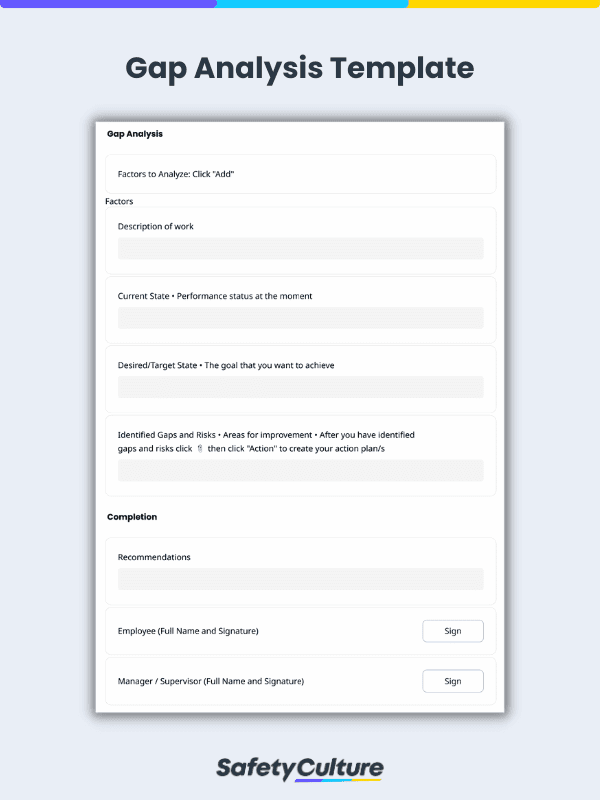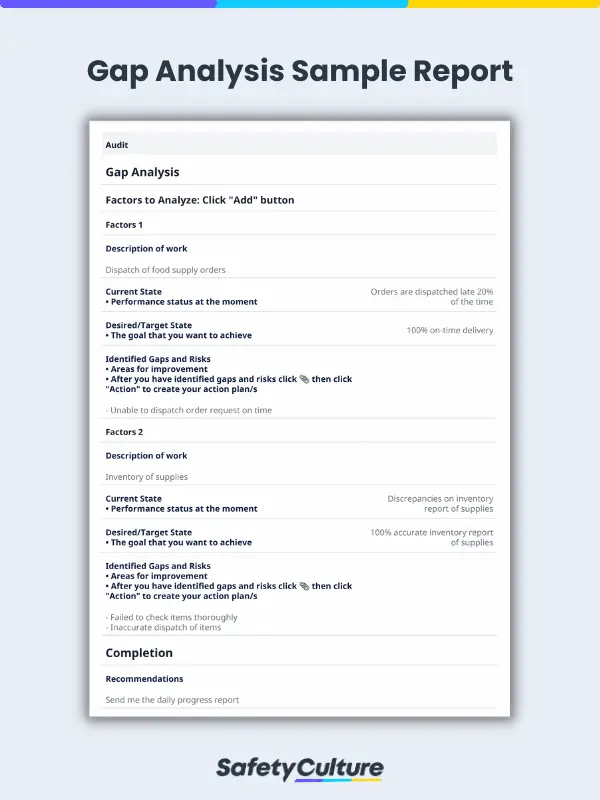What is a Gap Analysis Template?
A gap analysis template is a tool that businesses use to identify discrepancies between their current state and where they want to be in the future. It provides a structured framework that enables teams to pinpoint gaps, facilitating informed decision-making and creating action plans to bridge those gaps. This tool can be particularly helpful in conducting employee performance reviews and identifying process improvements toward business goals.
Why Use One
Incorporating a gap analysis template into your workflow enhances the precision, efficiency, and effectiveness of your analysis, ultimately leading to more successful goal achievement and strategic planning.
Apart from those, the following advantages also make it more worthwhile using such templates:
Consistency and Standardization
Templates promote consistency in the way gap analysis is conducted. This is especially valuable in organizations where multiple projects or departments are performing similar analyses.
Time and Resource Efficiency
Templates save time and resources by eliminating the need to create a gap analysis framework from scratch. This efficiency allows you to focus more on the analysis itself and the development of action plans to address identified gaps.
Data-Driven Decision-Making
Gap analysis templates often include space for data and documentation, enabling data-driven analysis. This data is invaluable for making informed decisions and setting priorities based on facts and evidence.
Clarity and Communication
Templates used during gap analysis facilitate clear and organized documentation of your insights and findings. This clarity is vital for effective communication among team members, stakeholders, and decision-makers.
What to Include in a Gap Analysis Template
Creating an effective gap analysis template requires careful consideration of the essential components that will help guide your assessment process. For employee performance reviews, here are some of the key elements you must include in a gap analysis template:
- Title Page – date and time of the review; the employee’s name, title, department, and employee number; and the HR manager/supervisor’s name
- Gap Analysis – factors to analyze, description of work, current state, desired/target state, identified gaps and risks, areas for improvement, action plans
- Completion Page – recommendations, employee and supervisor sign-offs
How to Conduct a Gap Analysis Using a Template
The first step of a gap analysis is to try and understand the status quo. Using a gap analysis template can help cross-functional teams to easily get started with gap analyses. A gap analysis template, or a gap analysis checklist, generally includes the following steps:
- Analyze the current state. Describe the performance status at the moment. How is the employee performing today? Are the needs of the employee being met?
- Describe the desired state. Think about the future goal and illustrate what it should look like.
- Identify the gaps and risks. Gaps are the difference between where you are and where you want to be. Analyze the root cause of the current challenge and outline the conditions for achieving the desired outcome.
- Outline a detailed action plan. Determine the exact steps in order of priority to close the gaps. The action plan should identify the solutions, the reasons why they are appropriate, and the necessary target dates of completion.
- Schedule the next follow-up date. This lets you monitor the progress of how action plans are being implemented. Also, you can address any issues that may arise during the process and keep everything and everyone on track.
Gap Analysis Report Example
A gap analysis report is a comprehensive document that specifically explains the gaps or deficiencies between the current and desired state and the action steps needed to best achieve the organization’s goals. It answers the following questions:
- “What do we wish to achieve?”
- “Where are we now?”
- “Why are we not there yet?”
- “How will we address the gap?”
A completed gap analysis report usually states the objectives and methodology, presents the gaps or challenges, and discusses communication and action plans and recommendations for future use.
With all those in mind, use a gap analysis tool as a guide to finish each step. Here’s a gap analysis example PDF report on employee performance:
FAQs About Gap Analysis Templates
While a gap analysis is commonly associated with sales and marketing, human resources, and business management, gap analysis templates can also be applied across a variety of functions and industries like manufacturing, project management, and energy conservation.
They can be particularly valuable in large-scale projects and organizations which often involve complex processes, numerous stakeholders, and extensive resources. Gap analysis templates provide a structured and systematic approach to identifying areas that require improvement or alignment with objectives.
Yes, using a template for gap analysis helps in the development of action plans that outline specific steps, responsibilities, and timelines for closing the identified gaps. This ensures that organizations can proactively work towards their strategic goals, allocate resources effectively, and monitor progress.
Gap analysis templates can provide a structured framework for organizations to assess their current risk management practices, identify gaps or deficiencies compared to industry standards or desired outcomes, and develop action plans to mitigate these risks. This systematic approach ensures that potential vulnerabilities and exposure to risks are proactively identified and addressed.




